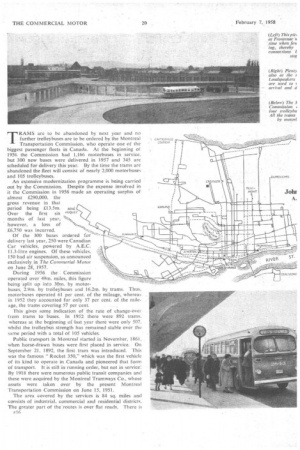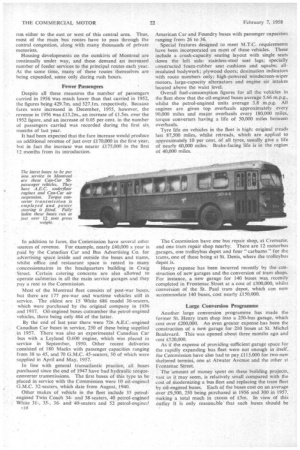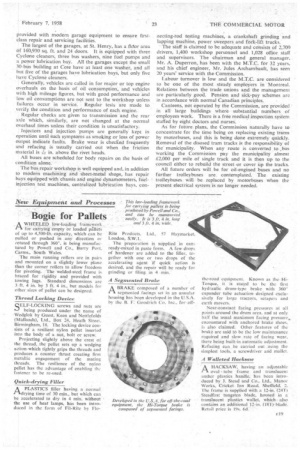ILERS ONLY
Page 65

Page 64

Page 66

Page 67

If you've noticed an error in this article please click here to report it so we can fix it.
r MONTREAL TRAMS are to be abandoned by next year and no further trolleybuses are to be ordered by the Montreal Transportation Commission, who operate one of the biggest passenger fleets in Canada. At the beginning of 1956 the Commission had 1,166 motorbuses in service, but 300 new buses were delivered in 1957 and 345 are scheduled for delivery this year. By the time the trams are abandoned the fleet will consist of nearly 2,000 motorbuses and 105 trolleybuses.
An extensive modernization programme is being carried out by the Commission. Despite the expense involved in it the Commission in 1956 made an operating surplus of almost £290,000, the
gross revenue in that period being £13,5m. RENE Over the first six HUQUET months of last year, however, a loss of £6,750 was incurred.
Of the 300 buses ordered for ELMHURST .6. delivery last year, 250 were Canadian Car vehicles, powered by A.E.C. 11.3-litre engines. Of these vehicles. 150 had air suspension, as announced exclusively in The Commerial Motor on June 28, 1957.
During 1956 the Commission operated over 49m. miles, this figure being -split up into 30m. by motorbuses. 2.9m. by trolleybuses and 16.2m. by trams. Thus, motorbuses operated 61 per cent. of the mileage, whereas in 1952 they accounted for only 37 per cent. of the mileage, the trams covering 57 per cent:
This gives some indication of the rate of change-over from trams to " buses. In 1952 there were 892 trams, whereas at the beginning of -last year there were only 507, whilst the trolleybus strength has remained stable over the same period with a total of 105 vehicles.
Public transport in Montreal started in November, 1861. when horse-drawn buses were first placed in service. On September 21, 1892, the first tram was introduced. This was the famous " Rocket 350," which was the first vehicle of its kind to operate in Canada and pioneered that form of transport. It is still in running order, but not in service: By 1918 there were numerous public transit companies and these were acquired by the Montreal Tramways Co., whose assets were taken . over by the present Montreal Transportation Commission on June 15, 1951.
The area covered by the services is 84 sq, miles and consists of industrial, commercial and residential districts. The greater part of the routes is over flat roads. There is
1-.16
an 800-ft. hill in the centre of the city, but no public service vehicles operate over it.
With the exception of one service, all the routes stay north of the St. Lawrence River and follow, the usual pattern of radiating in and out of the central commercial area,,where there are four main terminals. There are 95 bus routes, one of which is express and three are limitedstop services. Trolleybuses operate only four routes and trams account for 17. _
The shortest route is the 2A-1.7I miles—a loop service operating in the dockyard area, whilst the longest is the 86. which covers the 14.13 miles between Georges V tO 100 Avenue, running eastwards along the north bank of the river.
The territory covered is divided into a central zone, which has a uniform fare of 15 cents (Is. l(1.) for any distance, or two tickets for 25 cents (Is. 91d.). Passengers holding central-zone tickets may transfer free of charge-to other routes within the central zone.
Suburban or outer zones have a lower scale of charges, the flat fare being 8 cents (514). Four tickets are sold for 25 cents. Free transfer is restricted to other services, in each suburban zone. Because of the zonal system. the authorities were unable to supply figures showing the proportion of remunerative to unremunerative routes.
Following the general pattern of bus operation in most other parts of the world, the Commission are slaves to the morning and afternoon peak periods. Local industries generally work a five-day week and the morning rush covers a 2+-hr. period, because certain factories have staggered starting times. Special services are laid on to these factories, and this incentive is encouraging other concerns to follow suit.
The afternoon peak lasts only 14 hours, but on Friday evenings there is an additional peak period when many of the large shops remain open late. During off-peaks, 674 vehicles are in operation, whereas during the rush hours 1.723 buses and trams are placed in service.
Particularly during peaks there is heavy traffic congestion in the central area. One of the causes is the preponderance of private motorists, but another is the 800-ft. hill. To circumvent it, all east-west streets in the business area pass through a narrow band between the hill and the river, whilst all north-south main roads to the suburbs have to
run either to the east or west of this central area. Thus, most of the main bus routes have to pass through the central congestion, along with many thousands of private motorists.
Housing developments on the outskirts of Montreal are continually under way, and these demand an increased number of feeder services to the principal routes each year. At the same time, many of these routes themselves are being expanded, some only during rush hours.
Fewer Passengers
Despite all these measures the number of passengers carried in 1956 was much lower than that carried in 1952, the figures being 429.7m. and 5271m. respectively. Because fares were increased in December, 1955, however, the revenue in 1956 was £13.2m., an increase of £1.5m. over the 1952 figure, and an increase of 0.05 per cent. in the number of passengers carried was recorded during the first six, months of last year.
It had been expected that the fare increase would produce an additional revenue of just over £170,000 in the first year, hut in fact the increase was nearer £175,000 in the first 12 months from its introduction.
In addition to fares, the Commission have several other c.ources of revenue. For example, nearly £40,000 a year is paid by the Canadian Car and Bus Advertising Co. for advertising space inside and outside the buses and trams, whilst office and restaurant space is rented to many concessionnaires in the headquarters building in Craig Street. Certain catering concerns are also allowed to operate cafeterias in all the main service garages and they pay a rent to the Commission.
Most •of the Montreal fleet consists of post-war buses, but there are 177 pre-war and wartime vehicles still in service. The oldest are 15 White 686 model 36-seaters, which were purchased by the original company in 1936 and 1937. Oil-engined bases outnumber the petrol-engined vehicles, there being only 464 of the latter.
By the end of last 'rear there were 726 A.E.C.-engined Canadian Car buses in service, 250 of these being supplied in 1957. There was also an experimental Canadian Car bus with a Leyland 0.600 engine, which was placed in service in September, 1950. Other recent deliveries consisted of 180 Macks with passenger capacities ranging from 38 to 45, and 70 G.M.C. 45-seaters, 50 of which were supplied in April and May, 1957.
In line with general transatlantic practice, all buses purchased since the end of 1947 have had hydraulic torqueconverter transmissions. The first buses of this type to be placed in service with the Commission were 10 oil-engined G.M.C. 32-seaters, which date from August, 1940.
Other makes of vehicle in the fleet include 35 petroleogined Twin Coach 34and 38-seaters, 40 petrol-engined White 31-, 35-, 36and 40-seaters and 52 petrol-engined IR American Car and Foundry buses with passenger capacities ranging from 26 to 36.
Special features designed to meet l'vf.T.C. requirements have been incorporated on most of these vehicles. These include a crush-capacity seating layout with single seats down the left side: stainless-steel seat legs; specially constructed foam-rubber seat cushions and squabs; allinsulated bodywork; plywood doors: destination indicators with route numbers only; high-powered windscreen-wiper motors, large-capacity alternators and engine air intakes located above the waist level, Overall fuel-consumption figures for all the vehicles in the fleet show that the oil-engined buses average 5.66 m.p.g., whilst the petrol-engined units average 3.8 m.p.g. All engines are given top overhauls approximately every 90,000 miles and major overhauls every 180,000 miles, torque converters having a life of 50,000 miles between overhauls. .
Tyre life on vehicles in the fleet is high: original treads last 87,500 miles, whilst retreads, which are applied to approximately 10 per cent. of all tyres, usually give a life of nearly 60,000 miles. Brake-facing life is in the region of 40,000 miles.
The Commission have one bus repair shop, at Cremazie, and one tram repair shop nearby. There are 12 motorbus ,garages, one trolleybus depot and four " carbams " for the trams, one of these being at St. Denis, where the trolleybus depot is.
Heavy expense has been incurred recently by the construction of new garages and the conversion of tram shops. For instance, a new garage for 140 buses was recently completed in Frontenac Street at a cost of £300,000, whilst conversion of the St. Paul tram depot, which can now accommodate 140 buses, cost nearly £150,000.
Large Conversion Programme
Another large conversion programme has made the former St. Henry tram shop into a 250-bus garage, which cost over £200,000. An even greater expense has been the construction of a new garage for 210 buses at St. Michel Boulevard. This was opened about three months ago and cost £520,000.
As if the expense of providing sufficient garage space for the rapidly expanding bus fleet were not enough in itself, the Commission have also had to pay £115,000 for two new sheltered termini, one at Atwater Avenue and the other at Frontenac Street.
• The 'amount of money spent on these building projects, vast as it may seem, is relatively small compared with the cost of modernizing a bus fleet and replacing the tram fleet by oil-engined buses. Each of the buses cost on an average over £9,500, 250 being purchased in 1956 and 300 in 1957, making a total much in excess of £5m. In view of this Outlay it is only reasonable that such buses should be provided with modern garage equipment to ensure firstclass repair and servicing facilities.
The largest of the garages, at St. Henry, has a fidor area Of 160,930 sq. ft. and 24 doors. It is equipped with three Cyclone cleaners, three bus washers, nine fuel pumps and a power lubrication bay. All the garages except the small 30-bus building at Cote have at least one washer, and all hut five of the garages have lubrication bays, but only five have Cyclone cleaners.
Generally, vehicles are called in for major or top engine overhauls on the basis of oil consumption, and vehicles with high mileage figures, but with good performance and low oil consumptions are not sent to the workshop unless failures occur in service. Regular tests are made to verify the condition and performance of each engine.
Regular checks are given to transmission and the rear axle which, similarly, are not changed at the normal overhaul times unless their condition is unsatisfactory.
Injectors and injection 'pumps are generally kept in operation until such symptoms as smoking or loss of power output indicate faults. Brake wear is checked frequently and refacing is usually carried out when the friction material is J,L, in. above the rivet heads.
All buses are scheduled for body repairs on the basis of condition alone.
The bus repair workshop is well equipped and, in addition to modern machining and sheet-metal shops, has repair bays equipped with chassis arid engine dynamometers, fuel-injection test: machines, centralized lubrication bays. con
neeting-rod testing machines, a crankshaft grinding and lapping machine, power sweepers and fork-lift trucks.
The staff is claimed to be adequate and consists of 2,700 drivers, 1,400 workshop personnel and 1,028 office staff and supervisors. The chairman and general manager, Mr. A. Duperron, has been with the M.T.C. for 32 years, and his chief engineer, Mr. Jules Archambault, has seen 20 years' service with the Commission.
labour turnover is low and the M.T.C. are considered to be one of the most steady employers in Montreal. Relations between the trade unions and the management are particularly good. Pension and sick-pay schemes are in accordance with normal Canadian principles.
Canteens, not operated by the Commission, are provided in all large buildings where substantial numbers of employees work. There is a free medical inspection system staffed by eight doctors and nurses.
As for future plans, the Commission naturally have to concentrate for the time being on replacing existing trams by motorbuses, and this is being done extremely quickly. Removal of the disused tram tracks is the responsibility of the municipality. When any route is converted to ,bus working the Commission pay the municipality almost £2,000 per mile of single track and it is then up to the council either to rebuild the street or cover up the tracks.
All future orders will be for oil-engined buses and no further trolleybuses are, contemplated. The existing trolleybuses will be replaced by motorbuses when the present electrical system is no longer needed.
































































































































